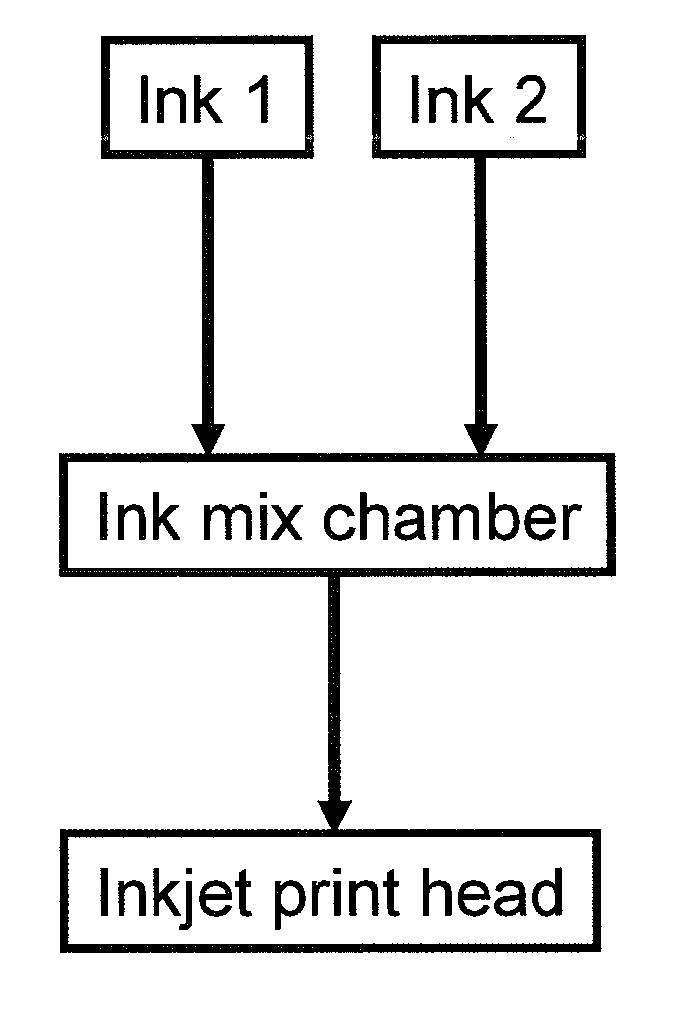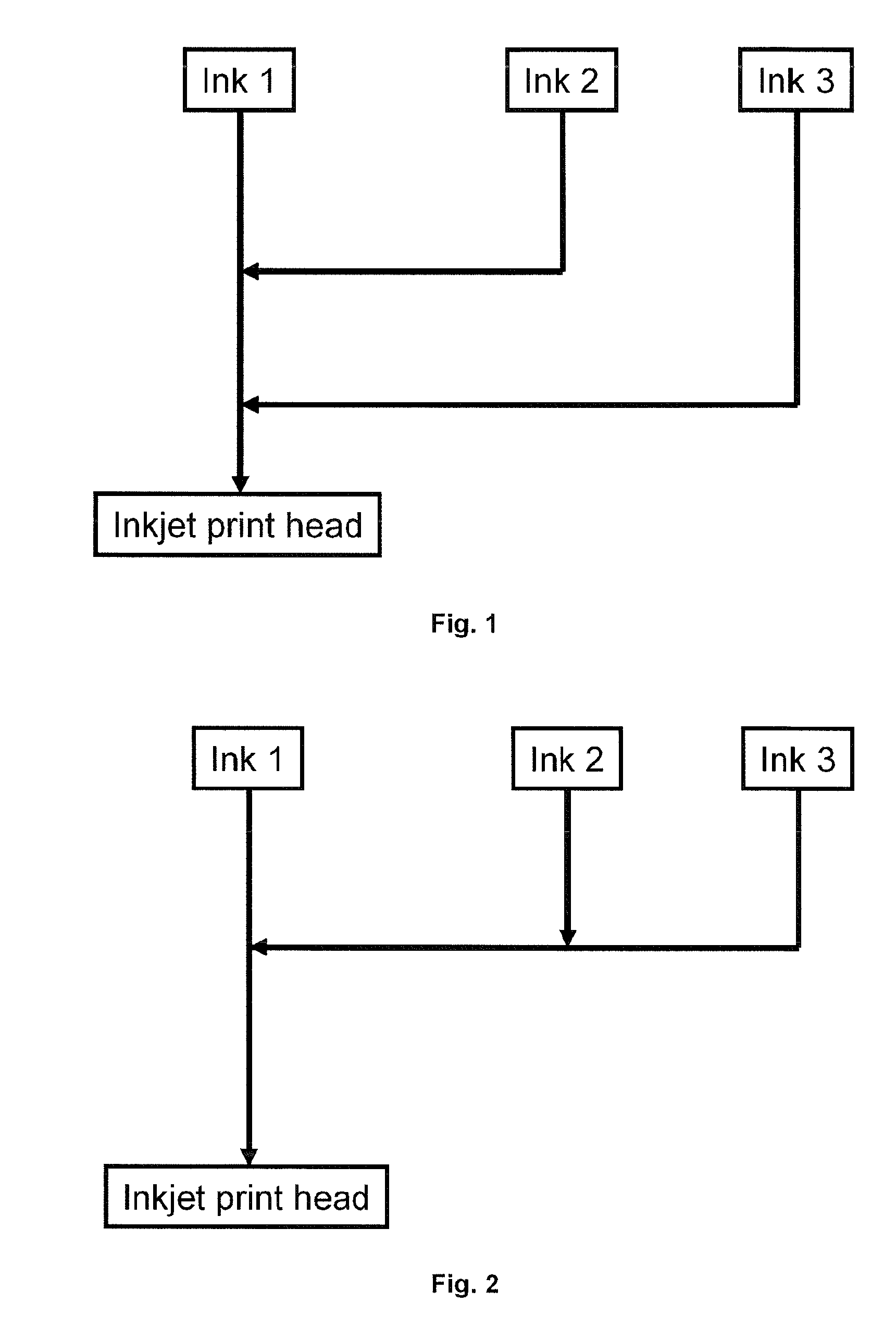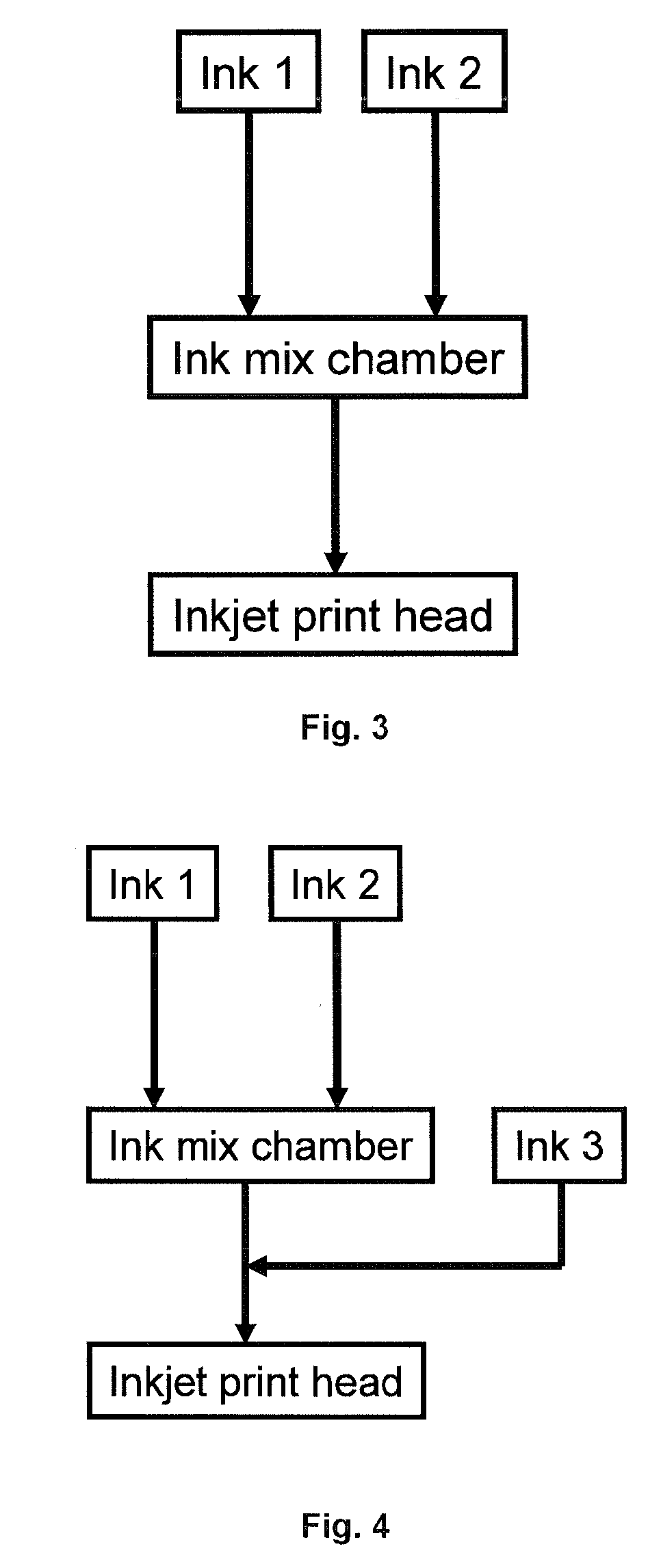3d-inkjet printing methods
a printing method and 3d technology, applied in the field of 3dinkjet printing methods, can solve the problems of insufficient adhesion and defects in image quality, inability to meet the needs of industrial printing environment,
- Summary
- Abstract
- Description
- Claims
- Application Information
AI Technical Summary
Benefits of technology
Problems solved by technology
Method used
Image
Examples
example 1
[0238]This example illustrates how the hardness of the cured layer can be varied by using mixtures of two inkjet fluids differing in composition, both fluids having different hardnesses after being cured.
Preparation of Inkjet Fluids
[0239]Fluid 1 and Fluid 2 were radiation curable inkjet fluids prepared by mixing the components under stirring at 20° C. to obtain a composition as shown in Table 1
TABLE 1wt % of:Fluid 1Fluid 2IBOA23.6330.00EBECRYL ™ 1123.83—CD9021—30.00GENOMER ™ 112234.4122.50SANTICIZER ™ 27812.9512.50IRGACURE ™ 8195.185.00
Preparation of Mixtures of Fluid 1 and Fluid 2
[0240]Mixtures of Fluid 1 and Fluid 2 were prepared according to Table 2. The percentages are weight percentages based upon the total weight of the mixture.
TABLE 2mixtureFluid 1Fluid 2MIX-1 0%100% MIX-225%75%MIX-350%50%MIX-475%25%MIX-5100% 0%
Evaluation
[0241]The mixtures MIX-1 to MIX-5 were each coated on a subbed clear PET film using a bar coater and a 10 μm wired bar.
[0242]Curing of the samples was perfo...
example 2
[0248]This example illustrates how the flexibility of the cured layer can be varied by the use of mixtures of two inkjet fluids differing in composition.
Preparation of Inkjet Fluids
[0249]Fluid 3 and Fluid 4 were radiation curable inkjet fluids prepared by mixing the components under stirring at 20° C. to obtain a composition as shown in Table 4.
TABLE 4wt % of:Fluid 3Fluid 4IBOA30.0060.10EBECRYL ™ 1130.0021.38GENOMER ™ 112222.50—SANTICIZER ™ 27812.5013.23IRGACURE ™ 8195.005.29
Preparation of Mixtures of Fluid 3 and Fluid 4
[0250]Mixtures of the Fluid 3 and Fluid 4 were prepared according to Table ˜5. The percentages are weight percentages based upon the total weight of the mixture.
TABLE 5mixtureFluid 3Fluid 4MIX-6 0%100% MIX-725%75%MIX-850%50%MIX-975%25%MIX-10100% 0%
Evaluation
[0251]The mixtures MIX-6 to MIX-10 were each coated on a subbed clear PET film using a bar coater and a 10 μm wired bar.
[0252]Curing of the coated samples was performed under a nitrogen inerting condition. The co...
example 3
[0257]This example illustrates how the visibility of a 3D-relief image can be improved by the use of an opaque fluid and a clear fluid.
Preparation of Fluids
[0258]Fluid 5 was a concentrated pigment dispersion of TiO2 in a dispersion medium constituted of a low viscous monofunctional polymerizable compound. Fluid 5 was prepared according to Table 7.
TABLE 7wt % of:Fluid 5TR5250.0PDISP10.0GENORAD ™ 161.0IBOA39.0
[0259]Fluid 5 was made by mixing 500.0 g of the white pigment TR52, 10.0 g of the inhibitor GENORAD™ 16, 333.3 g of a 30% solution of PDISP in IBOA, and 156.7 g IBOA using a DISPERLUX™ Laboratory Dissolver YELLOW075 from DISPERLUX S.A.R.L., Luxembourg. This mixture was subsequently milled in an Eiger Lab bead mill (from EIGER TORRANCE Ltd.) using yttrium-stabilized zirconium oxide-beads of 1-1.6 mm diameter (“high wear resistant zirconia grinding media” from TOSOH Co.) The bead mill was filled for 52% with the grinding beads and water-cooled during milling at 3000 rpm for 5 minut...
PUM
| Property | Measurement | Unit |
|---|---|---|
| solubility | aaaaa | aaaaa |
| wavelength range | aaaaa | aaaaa |
| height | aaaaa | aaaaa |
Abstract
Description
Claims
Application Information
 Login to View More
Login to View More - R&D
- Intellectual Property
- Life Sciences
- Materials
- Tech Scout
- Unparalleled Data Quality
- Higher Quality Content
- 60% Fewer Hallucinations
Browse by: Latest US Patents, China's latest patents, Technical Efficacy Thesaurus, Application Domain, Technology Topic, Popular Technical Reports.
© 2025 PatSnap. All rights reserved.Legal|Privacy policy|Modern Slavery Act Transparency Statement|Sitemap|About US| Contact US: help@patsnap.com



